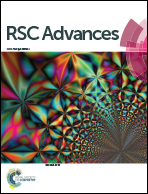Photocatalytic degradation of ibuprofen using titanium oxide: insights into the mechanism and preferential attack of radicals†
Abstract
The present work studied ibuprofen degradation using titanium dioxide as a photocatalyst. Mechanistic aspects were presented and the preferred attack sites by the OH˙ radical on the ibuprofen molecule were detailed, based on experimental and simple theoretical-computational results. Although some previous studies show mechanistic proposals, some aspects still need to be investigated, such as the participation of 4-isobutylacetophenone in the ibuprofen degradation and the preferred regions of attack by OH˙ radicals. The photodegradation was satisfactory using 0.03 g of TiO2 and pH = 5.0, reaching 100% decontamination in 5 min. The zeta potential curve showed the regions of attraction and repulsion between TiO2 and ibuprofen, depending on the pH range and charge of the species, influencing the amount of by-products formed. Different by-products have been identified by GC-MS, such as 4-isobutylacetophenone. Ibuprofen conversion to 4-isobutylacetophenone takes place through decarboxylation reaction followed by oxidation. The proposed mechanism indicates that the degradation of ibuprofen undergoes a series of elementary reactions in solution and on the surface. Three different radicals (OH˙, O2−˙ and OOH˙) are produced in the reaction sequence and contribute strongly to the oxidation and mineralization of ibuprofen and by-products, but the hydroxyl radical has a greater oxidation capacity. The simple study using the DFT approach demonstrated that the OH˙ radical attacks preferentially in the region of the ibuprofen molecule with high electronic density, which is located close to the aromatic ring (C![[double bond, length as m-dash]](https://www.rsc.org/images/entities/char_e001.gif) C bond). The presence of the OH˙ radical was confirmed through a model reaction using salicylic acid as a probe molecule.
C bond). The presence of the OH˙ radical was confirmed through a model reaction using salicylic acid as a probe molecule.



 Please wait while we load your content...
Please wait while we load your content...